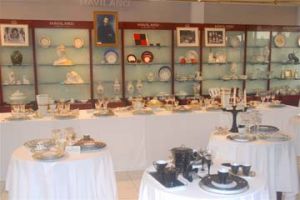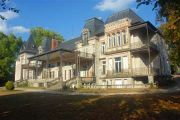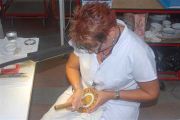 |

|
 Haviland porcelain © T. Joly Haviland porcelain © T. Joly

|
Some of the most famous French luxury brands have their workshops in the Haute-Vienne department. Guided tours allow you to discover an ancestral know-how and the factory stores are packed with bargains.
[ Practical ]
Getting there
- By road
390 km from Paris to Limoges on autoroutes A6b and A71
- By train
Teoz train from Paris Austerlitz to Limoges. The journey takes 3 hours.
- By plane
Flights to Limoges from Paris, Nice, Londres Stansted, Liverpool, Nottingham-East Midlands and Southampton.
Getting around
TER trains serve Saint-Junien and Saint-Léonard-de-Noblat. A car is more convenient.
Information : www.ter-sncf.com/limousin
Lodging
- Limoges
Bienvenue Hotel
Mercure Royal Limousin
Hôtel de la Paix
Ibis Centre
- Saint-Junien
Le Relais de Comodoliac
Le Bœuf Rouge
- Saint-Léonard-de-Noblat
Hotel Grand Saint-Léonard
Relais Saint-Jacques
Restaurants
- Limoges
Le Versailles
Les Petits Ventres
Chez Alphonse
La Cuisine
La Maison des Saveurs
- Saint-Junien
Auberge du Lauryvan
Le Relais de Comodoliac
Le Bœuf Rouge
- Saint-Léonard-de-Noblat
Hotel Grand Saint-Léonard
Relais Saint-Jacques
Companies
- Weston
Rue Nicolas Appert, 87000 Limoges
Tel : 0555047400
www.jmweston.com
- Haviland
Z.I Nord
Rue Philippe Lebon, 87000 Limoges
Tel : 0555047300
www.haviland-limoges.com
- Bernardaud
27 avenue Albert Thomas, 87000 Limoges
Tel : 0555105550
www.bernardaud.fr
- Agnelle
30 bd de la République, 87200 Saint-Junien
Tel : 0555021353
www.agnelle.fr
Le Moulin du Got
87400 Saint-Léonard-de-Noblat
Tel : 0555571874
www.moulindugot.com
Information
- Saint-Junien Tourist Office
Tel : 0555021793
www.saint-junien-tourisme.fr
- Limoges Tourist Office
Tel : 0555344687
www.tourismelimoges.com
- Haute-Vienne Tourist Office
Tel : 0555790404
www.tourisme-hautevienne.com
- Maison du Limousin
30 rue Caumartin, 75009 Paris
Tel : 0140070467
www.maisondulimousin.com
- Limousin Tourist Office
Tel : 0555110590
www.tourismelimousin.com
Bruce Willis, Jacques Chirac, Michael Jackson,… All these personalities have in common to wear or to have worn Weston shoes, the benchmark in luxury footwear for men. Their name may have an Anglo-Saxon ring but contrary to what most people think they are not produced in Great Britain but in France, in Limoges. Founded in 1891 by Edouard Blanchard, the company chose this name after Weston, Massachusetts, where his son travelled in 1904 to study Goodyear stitching techniques.
 Elegance and comfort Elegance and comfort
The Limoges Tourist Office sometimes offers tours of the factory where techniques are almost the same than the ones that were developed more than a century ago. Of course, some tasks have been automated, like leather cutting, but most of them are still made by hand. Besides, only high quality leathers are used and, in order to fit perfectly everyone’s feet, the company offers for each model a range of 3-7 widths per half-size. So it requires 150 to192 handlings and takes 5 to 6 hours spread over six weeks to fashion a Weston shoe !!!
This meticulous process gives them the elegance, the comfort, the solidity and the longevity accounting for Weston’s worldwide reputation. “ If you look after them carefully we can resole them three or four times and they can last for a lifetime” assures the factory director. It must be true because it happens that some people inheriting Weston shoes ask the company to adjust them to their feet to be able to wear them. “We can do it if the size difference is not too big”.
 Ninety kinds of leather Ninety kinds of leather
The price for this quality is that the two hundred and ten factory employees only produce 300 to 350 pairs of shoes per day. Priced from €150 to €1200, the models range from the traditional loafer that brought fame to Weston in the 80s to the modern classics lines. The company also produces about 1 500 special orders per year, all unique models sold from €1500, they are made up according to the customers’ fancy and mood. For that purpose, the factory has in stock more than ninety leathers of different origins and colours made from 5 to 6 months old calves skins – the most common – as well as from the skins of more exotic animals such as sharks, lizards, alligators raised in Louisiana farms,… And if you wish to buy a pair, a tiny shop waits for you. It doesn’t offer discount rates except during the January and June usual sales. On the other hand, thanks to the proximity of the factory, the choice of immediately available models is wider than in any other Weston boutiques.
 Largest collection of Limoges porcelain Largest collection of Limoges porcelain
However, there are great bargains in Limoges. You will find them in the factory stores of the fifteen or so porcelain makers installed in town. Born in 1771 thanks to the discovery of a source of kaolin in the region, this industry brought worldwide fame to the city. Nearby the historical centre dominated by the silhouette of the Saint Etienne cathedral silhouette, the Adrien Dubouché museum boasts the world largest collection of Limoges porcelain, including rare or unique models, as well as china and earthenware pieces from all over the world. Another small museum set up in the store of the Haviland factory showcases pieces decorated by artists such as Cocteau and Dali as well dinner services manufactured in the 19th and 20th centuries for various royal families and Presidents of the United States. This company was indeed founded by David Haviland, an American coming from a Quaker family.

 Haviland manor / Reynou park © T.Joly Haviland manor / Reynou park © T.Joly
|
 Beautiful mansion Beautiful mansion
An import broker for European ceramics, he first arrived in Limoges in 1842 with the intention of adding locally produced French hard-paste porcelain to the stocks of British soft-paste porcelain he was already importing. He soon found he needed to adapt the models to his American customers’ taste, so he and his brother Daniel opened decorative studios in 1847. Then, they founded a factory in 1864 and settled in Limousin where they built colonial and Louisiana styles beautiful mansions surrounded by parks planted with American trees. One is still visible in Le Vigen, inside the Reynou wildlife park. Their factory as well as the Royal Limoge one - the oldest still in activity – sometimes open their doors for guided tours organized by the Tourist Office. It gives you the chance to watch people at work and the porcelain manufacturing process that combines up to date techniques and traditional know-how.

 Haviland factory © T.Joly Haviland factory © T.Joly
|
 Young designers Young designers
In addition, the Royal Limoges compound also houses the ancient Casseaux kiln. Built in 1904 with more than 100 000 refractory bricks, it offered the possibility to fire simultaneously five tonnes of porcelain at 950°C and 1 400°C. Open to the public, it also includes a brief explanation of porcelain making. Consisting of about thirty stages, this process is shown in a more detailed way and with a modern scenography in the Bernardaud company foundation. There, you can also watch decorators at work and visit temporary exhibitions presenting dinner services and decorative objects by young designers who revitalize porcelain art. Several of them also have individual or collective showrooms throughout the town.
Situated thirty km East of Limoges, the town of Saint Julien has always been standing at the forefront of the leatherworking industry and is the French capital of glove making since the 17th century.
 Gloves for Sharon Stone and Madonna Gloves for Sharon Stone and Madonna
Established near a beautiful 11th – 13th century Romanesque collegial church, three companies perpetuate the tradition. Working for prestigious fashion houses and marketing models under they own brands as well, they account for 80% of the national production, in other words 480 000 pairs per year. The Ganterie de Saint Junien, a former cooperative that became a subsidiary of Hermès. Morand, which supplies Air France, the French police and designs the gloves worn by the French air force jet fighters pilots. Agnelle, that works for high fashion houses such as Dior, Lanvin and Givenchy. The company was thus commissioned to create gloves for Sharon Stones, the ones that Carla Bruni Sarkozy wore during the presidential trip in London, as well as leather and lace models for Madonna. Lamb skin is the most often used raw material, but it does also exist gloves made of deer, kid, crocodile, lizard, snake or kangaroo skins.
 Very attractive prices Very attractive prices
But those being often referred to as the Rolls Royce of gloves are made of peccary skin that is both soft and solid. From stretching the pelt to give the glove its essential elasticity and cutting, which is always done by men, to the fine stitching, which is undertaken by women, there are dozens of different operations involved and most of them are done by hand. As to the machines and tools that are used, they are virtually the same than 100 years ago. For instance, only traditional machines are used for the sewing because they provide a perfect finish unavailable with modern equipment.
This ancestral expertise can be discovered during guided tours organized by the Tourist Office as soon as five people are willing to do it. They take place in one of the three companies and always end in their factory store where prices are very attractive: from €25 to €45 for a regular pair, €80 for deer skin models and €100 for peccary gloves.
 Rag paper Rag paper
In the past, the Limousin region was also famous for rag paper production and in the 18th century twenty-four paper mills located around Saint Léonard-du-Noblat supplied the Parisian printers. Today, all but one have disappeared, the Moulin du Got. Built in the 15th century, it was saved by an association and brought back to life in 2003 after forty-nine years of closure. Now, it houses a paper mill, a print workshop and it is a living museum where visitors can watch every stage of book production. Above all, it is one of the only three European paper mills still producing hand formed sheets of papers from white hemp, linen and cotton rags. If the intended use is watercolours, only cotton ones are used while a mix of the three is better for engravings. These rags are mainly textile factories scraps that are tore to shreds and mixed with water and bit of glue in an old Dutch machine.
 Paper skirts Paper skirts
The papermaker then plunges a wooden frame with a fine net base into the vat and pulls it out loaded with the pulp that quickly dries and forms a sheet of velum paper. Besides, a 19th century cylinder papermaking machine developed to produce straw paper is now used to make large sheets of rag-based cardboard of various thickness for lithographic prints as well as crumpled paper to be turned into lampshades, book covers and sometimes skirts and long line bras. Lastly, small quantities of special papers made of various fibers are also produced on request. For example, labels for wine bottles have been produced using grape fibers first crushed by huge granite grinding wheels. Very much sought-after by artists and designers, all these papers are sold on the spot, by mail or used in the print workshop.
 Artists in residence Artists in residence
Equipped with machinery used by printers from around the end of the 18th century until the 1960s, it produced artworks, poetry books, invitations, visiting cards, menus and so on.
Texts and words are composed by hand using moveable letters or with a “linotype” machine while printing is done with a Stanhope machine from the late 18th century, a 19th century Minerva and an automatic Heidelberg platen from the 1950s. In addition, a special press for reproducing artwork engraved direct on copper plates, an early lithographic press and an embossing press which enables to produce special effects are also available for artists and fine arts students. The Moulin du Got indeed hosts artists in residence and regularly exhibits their works.
November 28, 2014
Thierry Joly 

|



